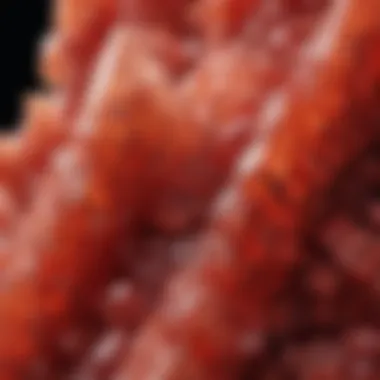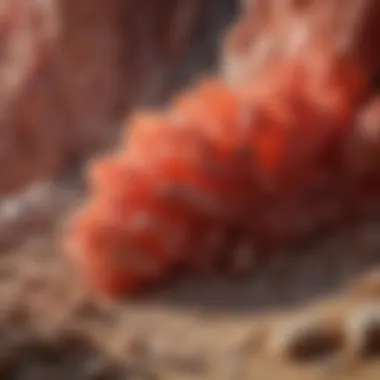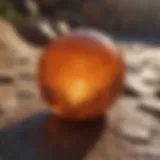Exploring Calcite Red: Properties and Significance


Intro
Calcite red is a mineral that catches the eye of many rock and fossil collectors. With its distinctive hue and characteristics, it reflects interesting geological aspects. Understanding its identification, collecting practices, preservation techniques, and geological insights is crucial for enthusiasts. This article will guide readers through these topics, providing a comprehensive perspective on calcite red.
Rock and Fossil Identification
Identifying rocks and fossils is a fundamental skill for collectors. Knowing the right characteristics to look for can enhance your collection significantly. Usually, calcite red appears attractively in thick, colorful formations.
Types of Rocks and Fossils
Calcite red is part of the calcite family, often found in sedimentary environments. It may have numerous types, ranging from marble-like formations to stalactites in caves. Other associated rocks can include limestone and chalk—all bearing features worthy of investments.
Characteristics To Look For
When identifying calcite red, consider these features:
- Color: Often bright red to orange-red.
- Shape: Can be in rhombohedral forms but varies by location.
- Hardness: Identified by its relative softness to other minerals.
- Cleavage: Examine how it breaks, as calcite notably has rhombohedral cleavage.
- Luster: It typically shines when polished, showcasing its attractiveness to collectors.
Tools for Identification
Having decent tools helps in confirming your findings. Here are some tools to consider:
- Hand lens for examining details closely.
- Scratch test kit for hardness assessment.
- A field guide for reference. Using these tools enhances both accuracy and enjoyment during identification.
Collecting Tips and Techniques
Collection practice requires thoughtful strategies. Knowing best techniques leads to fruitful efforts and rewarding finds.
Best Practices for Collecting
- Research locations: Certain areas yield better specimens.
- Permits and permission: Always check regulations for collecting in a specific locale.
- Respect the environment: Be mindful not to disturb ecosystems while collecting rocks and fossils.
Locating Prime Collecting Sites
Explore places known for significant calcite findings. Some renowned sites include:
- White River Badlands in South Dakota.
- Chalk cliffs on the southern coast of England.
- Caves in Texas known for mineral formations.
How to Safely Extract Specimens
When extracting calcite red, use caution:
- Carry a sturdy bag that can protect the specimens.
- Use appropriate tools to minimize damage. Avoid overexerting yourself; precision matters over effort.
Preservation and Display
Proper preservation of calcite red contributes to its longevity, ensuring collectors keep the mineral in optimal condition for years.
Techniques for Preserving Rocks and Fossils
- Cleaning: Use a soft brush to remove dirt without scratching the surface.
- Sealing: Consider a light sealer to enhance shine and protect the surface.
Proper Storage Methods
Store specimens away from direct sunlight to prevent fading. Ideally, use:
- Display cases to protect from dust and damage.
- Cotton or sponge for cushioning and stabilization during storage.
Creative Display Ideas
Display enjoys personalization. Options include:
- Framed specimens on walls as art.
- Shelves with labels for informative touch.
- Glass vitrines for a professional atmosphere that showcases the beauty.
Geological Insights


Understanding geology complements the interest in calcite red and enriches contextual knowledge. Geological sources enhance appreciation for the uniqueness of each formation.
Geological Formations and Processes
Calcite red often appears in areas altered by various natural processes, like evaporation, which provides insight into historic climates. The formation commonly results from slow sediment accumulation over millennia.
Historical Significance of Rocks and Fossils
Rocks display layers of the Earth’s history. Awareness of previous environmental conditions aids in deciphering Earth’s past. This includes understanding how regional geology interacts with larger epochs like previous ice ages.
Notable Discoveries in the Field
Keep an informed perspective on collecting. For example, many participants in group forums share findings about rare specimens. Websites like Reddit often highlight these discussions.
Understanding Calcite
In the study of calcite red, it is crucial to first grasp the significance of its parent mineral, calcite. Understanding calcite is important in several ways. Firstly, it sets the context for understanding the unique properties and characteristics of calcite red. Secondly, calcite serves as a fundamental element of many geological processes, making its study relevant to various fields such as mineralogy and geology. This article explores various essential dimensions of calcite, enhancing the knowledge of rock and fossil collectors seeking to appreciate calcite red to the fullest.
Defining Calcite
Calcite is a common carbonate mineral, composed mainly of calcium carbonate (CaCO3). As a prevalent mineral in the Earth’s crust, calcite can form in various geological environments, ranging from sedimentary deposits to metamorphic rocks. Understanding calcite involves recognizing its occurrence in a wide array of natural settings. These include limestone formations, where it can be found as a key component, as well as the formation of stalactites and stalagmites in caves. The texture and properties of calcite are shaped by the conditions under which it crystallizes, resulting in different varieties including the vibrant calcite red.
Chemical Composition
The chemical composition of calcite plays a key role in its characteristics and properties. Being primarily made up of calcium carbonate, its composition allows calcite to exhibit a range of features. Specifically, the incorporation of trace elements can lead to coloration variances; this is especially true for calcite red, often colored by iron impurities. The predictable chemistry of calcite offers collectors a clear framework for assessing its quality and other attributes.
Physical Properties
The physical properties of calcite constitute essential factors in identification and valuation. Key properties include:
- Hardness: On the Mohs scale, calcite generally rates around 3, which means it is relatively soft and can be scratched with a fingernail.
- Cleavage: Calcite exhibits perfect cleavage in three directions, resulting in rhombohedral fragments. This important feature is vital during specimen identification.
- Luster: Calcite can display a vitreous to pearly luster, particularly when polished, enhancing its aesthetic value.
- Transparency: Energy transmission varies; calcite can be transparent to translucent, expanding its usage in decorative applications.
These properties fundamentally affect how collectors approach both identifying and appreciating various calcite forms, especially the appealing calcite red.
Characteristics of Calcite Red
Understanding the characteristics of calcite red is crucial for those who collect minerals and fossils. This variant of calcite exhibits unique traits that set it apart from other minerals within the same family. Several factors influence its appeal, making it highly desirable among collectors and enthusiasts alike.
Color Variability
Calcite red is well-known for its rich color spectrum which can range from deep crimson to light rose. This color variability often depends on the presence of impurities or different formation environments. For example, iron oxide is a significant contributor to the red hue. Additionally, light can enhance the perceived vibrancy of the color, making some specimens appear more vivid when illuminated appropriately. Collectors often seek samples with consistent, intense colors—leading to a robust market demand for vivid specimens. Identifying quality calcite red mineralization often revolves around this color factor, influencing not only collectible value but its aesthetic appeal within mineral displays.
Texture and Luster
The textural properties of calcite red also play an integral role. These specimens generally exhibit a smooth texture when polished; however, as mined specimens, they can range widely in feel from rough to finely granular. This wide range reflects varied geological conditions in which they were formed.
In terms of luster, calcite red displays a distinct vitreous quality, contributing to its overall appealing look. When light interacts with the surface, it can reveal subtle contrasts, bringing out creamy tones or even play of colors in well-formed crystals. Minerals with these poised attributes are particularly sought after by miners and enthusiasts, as they often serve practical and decorative purposes alike.
Crystal Structure
The crystal structure of calcite red is predominantly rhombohedral, a characteristic trait for the entire calcite family. Calcite takes structure and symmetry seriously, with perfect cleavage being a noteworthy aspect as well. Crystals are typically transparent or translucent, which also speaks to their desirability in different domains, from geological specimens to ornamental pieces.
The underlying atomic structure contributes to the unique cleavage properties; this allows calcite to be split along specific planes. This characteristic is vital not just for careful display but also for techniques used in art and construction. By understanding how these structures influence the mineral’s performance and adaptability, collectors can appreciate both the complexity and utility of this mineral.
"Understanding the characteristics of calcite red enriches both collecting and scholarly appreciation for this remarkable mineral."
The Formation of Calcite Red
Understanding the formation of Calcite Red provides intricate insights into its characteristics and significance. This section elucidates the geological processes and environmental conditions aiding its secretion in the Earth’s crust. Recognition of how these minerals formulate paves the pathway to better appreciate their qualities and foster conservation efforts among collectors.
Geological Processes
The geology behind Calcite Red is complex, featuring a series of intricate processes. Calcite is primarily formed through processes like sedimentation, crystallization, and metamorphism. Originating from the calcium carbonate found mainly in marine environments, it undergoes various transformations under differing conditions. This variaton includes factors like time, pressure, and temperature which shape the mineral considerably.
When submerged under water, organisms such as corals and shellfish utilize calcium to produce carbonates. Once they perish, their remains accumulate on seafloors. Over massive periods, geological activities, including tectonic movements and sediment compaction, provoke changes within these accumulations, turning them into solid rock formations. Calcite Red's vivid color results from impurities, such as iron and manganese, clinging to the crystal lattice during condemnation, guiding several collectors to its visual appeal.
Environmental Conditions


Environmental factors significantly influence the formation of Calcite Red. The surrounding conditions at the formation site dictate whether a mineral crystallizes with optimal qualities. For instance, precipitation and crystalline structures link directly to temperature and pressure gradience in a geological context. If conditions are stable, high-quality calcite can develop. Conversely, turbulence can produce micro-flaws, impacting its physical attributes.
In addition, the pH level of the water influencesen crystallization. Variances due for instance to localized geological processes or the inflow of minerals can cause fluctuating pH parameters, further amplifying the mineral's specific features. This contributes not just to calcite red’s uniqueness but also establishes its classification among a wider array of calcite types, navigating a significant path toward gemmology and collectors' preferences.
Comparison with Other Calcite Types
Comparing Calcite Red with other calcite variants reveals essential knowledge about its uniqueness. While calcium carbonate forms the basic component in many calcite types, the concentrations of trace elements lead to distinguishable characteristics. Other variants, like Calcite Blue or Calcite Yellow, also owe colors to their specific impurities.
The geographic region where calcite forms has its role too. Geographic realities and the composition of surrounding rocks help dynamic crystallization and, subsequently, the varietal traits. A collector's understanding of differences could greatly affect their choices when scouting for rare variants.
Gathering information on these factors enhances a dealer's approach toward offering sound guidance on Calcite Red procurement. An analysis of these mineral types thickens one's mineralogical acumen and promotes this niche interest through engaged collecting practices.
It is important to stay updated on geological practices as it sheds light on newly discovered intricacies about various calcite types.
Collecting Calcite Red
Collecting calcite red presents an enriching experience for both amateur rock enthusiasts and seasoned geologists. The beauty and diversity of this mineral not only attracts collectors but also represents a window into the geological processes that shape our planet. Understanding the essential aspects of collecting this striking mineral can greatly enhance your collection's quality and value.
Identifying Quality Specimens
Identifying quality calcite red specimens requires careful attention to detail. When assessing a specimen, look for vibrant red hues that are typically more desirable. The vibrancy of the color can vary significantly; hence, deeper shades often fetch a higher value among collectors. Besides color, faults or inclusions in the mineral can detract from a specimen's quality. Look for transparency or flat surfaces when observing physical properties. An examination under good lighting can also provide insights into any iridescence, which adds to the mineral's character.
Furthermore, taking time to understand the crystal structure of calcite red helps in discerning quality. Ideally, a well-formed rhombohedral crystal structure signifies a superior specimen. It is advised to research similar specimens, comparing them with what you find to better determine clarity and completeness.
Optimal Locations for Collection
The globe offers various regions rich in calcite red deposits. Identifying these locations can elevate your collecting expeditions. Notable areas include the Flint Hills of Kansas and some locations in Ohio and western New York. Such places are known for their ample calcite outcrops.
Also, considering factors like geological composition in the area can aid in pinpointing successful sites. For example, areas near limestone hills generally yield a better catch of calcite red. Collecting in the right location not only increases your chances of finding quality specimens; it can also lead to engaging experiences with nature and geology at large.
Remember: Respecting local regulations and ethical collecting practices is crucial. Always seek permission when necessary and prefer sites where collecting is encouraged.
Tools for Collecting
Selecting appropriate tools for collecting enhances the chances of success while ensuring care for the specimens. A basic toolkit for calcite red collection usually includes:
- Hammers: A rock hammer specifically designed for mineral collection can effectively break away calcite.
- Chisels: Useful for more controlled sampling away from larger boulders or hard structures.
- Safety goggles: Protecting eyes from debris is vital when collecting.
- Brushes: Soft-bristled brushes help remove dirt without damaging the specimen’s surface.
- Field guide: A regional geological guide can assist in the identification of sites and varietals.
Packing these tools for exploring promising locations can make a significant difference. Having the right tools ensures a more safe and fruitful experience, allowing any rock and fossil collector to increase the stellar quality of their precious calcite red collection.
Preserving Calcite Red
Preserving calcite red is essential for maintaining its unique physical attributes, historical significance, and value as a collector's item. Over time, calcite variants may face degradation due to environmental factors. Thus, understanding proper methods of storage and preservation can significantly impact a specimen's longevity. Proper preservation not only enhances appearance but also crucially safeguards investments of enthusiasts and serious collectors alike.
Proper Storage Techniques
Storing calcite red requires careful planning. The aim is to protect the specimens from light, humidity, temperature fluctuations, and physical shock.
- Use Soft Materials: Wrap calcite red specimens in soft, non-abrasive cloths to prevent scratches.
- Controlled Environment: Keep the fossils in dark, dry locations. Ideally, a well-ventilated space with controlled temperature is best.
- Acid-Free Containers: Store in clearly labeled, acid-free boxes or containers to avoid any chemical reactions.
- Avoid Plastics: Limit contact with plastic materials; they can emit harmful chemicals over time.
- Regular Inspections: Periodically review the condition of the specimens to swiftly identify any potential damage or deterioration.
Taking these steps minimizes the risk of climate-related damage and preserves the physical properties of calcite red.
Common Preservation Challenges
Despite best efforts, preserving calcite red can present obstacles. Some common challenges include:
- Humidity Exposure: High moisture can lead to mineral degradation. It is vital to monitor the humidity levels in storage areas and use silica gel if needed.
- Temperature Fluctuations: Rapid shifts can cause cracking. Ideally, keep specimens in regions with consistent temperatures.
- Physical Damage: Handling without care can result in chips or fractures. Use tools designed for handling delicate specimens.
- Contamination: Extreme sensitivity to pollutants requires inner-packaging materials to be cleaned and only non-toxic products should be used.
Being mindful of these challenges can significantly enhance the lifespan of calcite red specimens and ensure they retain their collectible value.
The Role of Calcite Red in Geology
Significance in Geological Research
Calcite red plays a pivotal role in geological research, representing not only a unique mineral variant but also a window into the Earth's processes. Scientists often study calcite red to gain insights into sedimentary environments where these minerals form. The distinct reddening influences, stemming from various impurities or mineral relationships, shed light on previous conditions affecting geological formations.


By examining the composition of calcite red, geologists can understand the history of ancient ecosystems. This includes exploring how changing environmental conditions, such as temperatures and pH levels, influenced mineral deposition. Records of these transitions can explain and predict shifts in geologic occurrences, benefitting researchers in energy resource exploration and extraction activities, providing crucial data on the formation of natural resources.
Implications for Mineralogy and Petrology
Calcite red has noteworthy implications in the fields of mineralogy and petrology. This type of calcite often possesses fascinating textural and compositional attributes, setting it apart from its conventional counterparts. These distinctions permit advanced studies on crystallography and geochemistry. For students and collectors, calcite red specimens become more than mere visual attractions; they serve as essential samples that aid in discerning the evolution of minerals over time.
Understanding the interplay of different mineral phases allows for a more nuanced interpretation of rock formations. Calcite red, frequently associated with other minerals, can illustrate the dynamism within metamorphic processes. Such knowledge is invaluable for performers within the industry striving for innovations in material exploration or production. Enthusiasts armed with comprehensive knowledge can significantly appreciate their collecting prospects and deepen their insights into captvating geological narratives.
The study of calcite red is crucial, enabling advanced analysis of the geological landscape that characterizes regions rich in sedimentary processes.
In summary, the role of calcite red extends well beyond aesthetic allure. By integrating knowledge of its geological significance, enthusiasts and professionals alike gain leverage in various disciplines of earth science.
Aesthetic and Commercial Value
Calcite Red holds significant aesthetic and commercial value in both the mineral collecting community and the realms of art and design. Its appealing shades, ranging from vibrant scarlet to muted garnet, draw both novice enthusiasts and seasoned collectors. The beauty of this mineral lies not just in its coloration, but in the play of light across its crystal faces. This optical quality can transform a simple stone into a remarkable piece of decor.
Market Demand for Calcite Red
The growing interest in natural stones has led to an increase in market demand for Calcite Red. Several factors influence this trend:
- Collector Interest: Rock and fossil collectors prioritize unique specimens. Calcite Red’s rarity compared to other varieties creates demand for pristine examples.
- Educational Value: Geological programs and institutions seek specimens for teaching purposes. Calcite Red’s formation processes illustrate the complexities of mineralogy effectively.
- Investment Potential: As interest grows, individuals view Calcite Red as a tangible asset. Its value may appreciate over time, leading to speculative collectors entering the market.
These factors create a dynamic market environment where high-quality pieces often fetch excellent prices at auctions and trade shows.
Usage in Decorative Arts
Calcite Red finds utility in decorative arts, owing to its engaging appearance. Artists and designers use it for various purposes:
- Jewelry Making: Designers incorporate Calcite Red in custom jewelry, seeking to enhance uniqueness and personal expression. The stone is often cut into cabochons or beads.
- Home Decor: Interior designers use Calcite Red in sculptures, bookends, and tabletops. The mineral can introduce a touch of elegance and nature into modern spaces.
- Art Installations: Contemporary artists integrate Calcite Red into installations to invoke themes of geology and natural beauty.
Considering these utilizations, Calcite Red continues to inspire creativity and appreciation in artistic endeavors across diverse platforms. In summary, its aesthetic and commercial values position Calcite Red as a coveted choice among collectors and artists alike.
Calcite Red in Popular Culture
Calcite Red holds a place beyond its geological significance, often weaving itself into the fabric of cultural narratives and artistic expressions. This section elucidates how calcite red captivates the imagination of various societies and the meanings attributed to it. Through exploring its cultural references and symbolic roles, we acknowledge its profound impact, not just as a mineral but as a reflection of human creativity and belief systems.
Cultural References
Throughout history, calcite red has been mentioned in various cultural works, ranging from literature to art. Artists frequently use calcite red instances in their work to evoke a certain emotional response or to capture the beauty of the natural world. Museums also hold exhibitions where calcite red specimens get prominent display, showcasing their aesthetic value.
In certain Native American traditions, specific red stones, believed to possess healing properties, appear in cultural stories and practices. These tales often describe the earth as a living entity, where calcite red symbolizes the blood of the earth.
Furthermore, in modern media, calcite red reflects strength and vitality, appearing in various artistic representations in films and sculptures. These depictions highlights its enduring allure and rich associations in human culture.
Symbolism in Different Societies
The symbolic resonance of calcite red varies significantly across different cultures.
- In some African tribal traditions, red stones symbolize strength, vitality, and protection, often seen in ceremonial artifacts.
- For many Eastern cultures, red embodies good luck and happiness, making calcite red a favored material in art, jewelry, and decorations.
- Conversely, in Western societies, the color red often has dual meanings, representing both passion and danger. Thus, calcite red can evoke a range of responses depending on contextual bias and social norms.
This rich modulation of meanings invites deeper contemplation regarding how humans perceive minerals and colors and their place in the psyche.
Future Trends in Calcite Red Research
The research on calcite red is at an intriguing juncture, presenting opportunities to enhance our understanding of this unique mineral. As new technological advancements are created, it is becoming clearer how these can impact the study and appreciation of calcite red. Ongoing research efforts could uncover more details surrounding its formation processes and increase its utility in various fields. Data amassed over time will inform future methodologies and discussions, ultimately ushering in our next big leap within this specialized area of collective knowledge.
Advancements in Analytical Techniques
Analytical techniques in mineralogy have seen notable growth over the past years. Advances in tools like laser ablation inductively coupled plasma mass spectrometry or high-resolution imaging have transformed the examination of minerals.
These advancements allow scientists to analyze calcite red at a molecular level, providing insights into its elemental composition and impurities. Improved microanalytical methods help detect trace elements that were once challenging to identify. As a result, researchers can connect the elemental profiles of calcite red to specific geological conditions or environmental influences.
This shift does not just enhance mineral identification; it also informs geological history and implications such as ancient environments and emergent earth processes.
Potential Discoveries and Applications
The evolving landscape of calcite red research opens the door for many outlooks. Two major fields stand out: geological applications and commercial opportunities. As understanding increases regarding how calcite red is tied to certain mineral deposits, exploration strategies can also change.
There is potential for new discoveries that might identify areas rich in calcite red, offering promising sites for collectors and investors alike. Benefits in restoring ecosystems and fighting climate change through carbon capture technologies are also emerging fields. The role of calcite, generally, in sequestering carbon dioxide shows how calcite red, like its counterparts, might engage in sustainable practices.
Furthermore, the beauty and uniqueness of calcite red maintain public interest. Jewelers and artisans could leverage these insights to create innovative and sustainable designs in the decorative arts sector. The prospect of exploring calcite red could attract collaboration between companies, researchers, and collectors, ideally promoting innovation in practical applications and aesthetic designs.
To summarize, research investing in analytical techniques seemingly holds significant potential for the future, expected to bring nuggets of knowledge and discovery that may excite both scientists and collectors alike.







